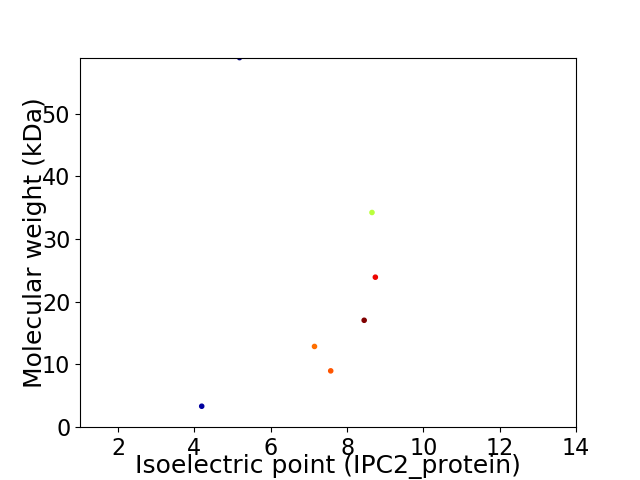
Microviridae sp. ctD0m35
Taxonomy: Viruses; Monodnaviria; Sangervirae; Phixviricota; Malgrandaviricetes; Petitvirales; Microviridae; unclassified Microviridae
Average proteome isoelectric point is 7.11
Get precalculated fractions of proteins

Virtual 2D-PAGE plot for 7 proteins (isoelectric point calculated using IPC2_protein)
Get csv file with sequences according to given criteria:
* You can choose from 21 different methods for calculating isoelectric point
Summary statistics related to proteome-wise predictions



Protein with the lowest isoelectric point:
>tr|A0A5Q2W9V5|A0A5Q2W9V5_9VIRU Putative minor capsid protein OS=Microviridae sp. ctD0m35 OX=2656694 PE=4 SV=1
MM1 pKa = 8.07PDD3 pKa = 3.24YY4 pKa = 11.15DD5 pKa = 3.62QLFPHH10 pKa = 7.12GSSDD14 pKa = 4.02YY15 pKa = 10.93DD16 pKa = 3.95GSWVLIKK23 pKa = 10.09MPWGCPP29 pKa = 3.22
MM1 pKa = 8.07PDD3 pKa = 3.24YY4 pKa = 11.15DD5 pKa = 3.62QLFPHH10 pKa = 7.12GSSDD14 pKa = 4.02YY15 pKa = 10.93DD16 pKa = 3.95GSWVLIKK23 pKa = 10.09MPWGCPP29 pKa = 3.22
Molecular weight: 3.34 kDa
Isoelectric point according different methods:
Protein with the highest isoelectric point:
>tr|A0A5Q2WAC6|A0A5Q2WAC6_9VIRU Replication associated protein OS=Microviridae sp. ctD0m35 OX=2656694 PE=4 SV=1
MM1 pKa = 7.09EE2 pKa = 5.62HH3 pKa = 6.97NYY5 pKa = 10.66DD6 pKa = 4.81AILNQMPFVGLFLGGILSAVAKK28 pKa = 9.55PIISVAAKK36 pKa = 10.18ALPFLKK42 pKa = 10.61NNAGSIINAGGNIAGGLIGAEE63 pKa = 4.09GAEE66 pKa = 4.58DD67 pKa = 3.9ANSANAMLARR77 pKa = 11.84EE78 pKa = 3.93NRR80 pKa = 11.84DD81 pKa = 2.87WQEE84 pKa = 3.8RR85 pKa = 11.84MSNTAHH91 pKa = 5.4QRR93 pKa = 11.84EE94 pKa = 4.51VEE96 pKa = 4.18DD97 pKa = 4.67LRR99 pKa = 11.84AAGINPILSAKK110 pKa = 10.17FGGSSTPPGNVATMTNPGEE129 pKa = 4.03FTGAGISSAGQAYY142 pKa = 6.65WTSQLTRR149 pKa = 11.84EE150 pKa = 4.11QVLTQRR156 pKa = 11.84SVQSVNSAQAMASRR170 pKa = 11.84AAALKK175 pKa = 10.73SLIDD179 pKa = 3.61AQKK182 pKa = 10.42IKK184 pKa = 11.27AEE186 pKa = 4.01IPAVQAQSEE195 pKa = 4.58RR196 pKa = 11.84EE197 pKa = 4.19SQGGDD202 pKa = 2.56IRR204 pKa = 11.84NSKK207 pKa = 9.58FFKK210 pKa = 8.49PFKK213 pKa = 9.79WFGEE217 pKa = 4.09IKK219 pKa = 9.67RR220 pKa = 11.84QIMGRR225 pKa = 3.56
MM1 pKa = 7.09EE2 pKa = 5.62HH3 pKa = 6.97NYY5 pKa = 10.66DD6 pKa = 4.81AILNQMPFVGLFLGGILSAVAKK28 pKa = 9.55PIISVAAKK36 pKa = 10.18ALPFLKK42 pKa = 10.61NNAGSIINAGGNIAGGLIGAEE63 pKa = 4.09GAEE66 pKa = 4.58DD67 pKa = 3.9ANSANAMLARR77 pKa = 11.84EE78 pKa = 3.93NRR80 pKa = 11.84DD81 pKa = 2.87WQEE84 pKa = 3.8RR85 pKa = 11.84MSNTAHH91 pKa = 5.4QRR93 pKa = 11.84EE94 pKa = 4.51VEE96 pKa = 4.18DD97 pKa = 4.67LRR99 pKa = 11.84AAGINPILSAKK110 pKa = 10.17FGGSSTPPGNVATMTNPGEE129 pKa = 4.03FTGAGISSAGQAYY142 pKa = 6.65WTSQLTRR149 pKa = 11.84EE150 pKa = 4.11QVLTQRR156 pKa = 11.84SVQSVNSAQAMASRR170 pKa = 11.84AAALKK175 pKa = 10.73SLIDD179 pKa = 3.61AQKK182 pKa = 10.42IKK184 pKa = 11.27AEE186 pKa = 4.01IPAVQAQSEE195 pKa = 4.58RR196 pKa = 11.84EE197 pKa = 4.19SQGGDD202 pKa = 2.56IRR204 pKa = 11.84NSKK207 pKa = 9.58FFKK210 pKa = 8.49PFKK213 pKa = 9.79WFGEE217 pKa = 4.09IKK219 pKa = 9.67RR220 pKa = 11.84QIMGRR225 pKa = 3.56
Molecular weight: 23.92 kDa
Isoelectric point according different methods:
Peptides (in silico digests for buttom-up proteomics)
Below you can find in silico digests of the whole proteome with Trypsin, Chymotrypsin, Trypsin+LysC, LysN, ArgC proteases suitable for different mass spec machines.| Try ESI |
 |
|---|
| ChTry ESI |
 |
|---|
| ArgC ESI |
 |
|---|
| LysN ESI |
 |
|---|
| TryLysC ESI |
 |
|---|
| Try MALDI |
 |
|---|
| ChTry MALDI |
 |
|---|
| ArgC MALDI |
 |
|---|
| LysN MALDI |
 |
|---|
| TryLysC MALDI |
 |
|---|
| Try LTQ |
 |
|---|
| ChTry LTQ |
 |
|---|
| ArgC LTQ |
 |
|---|
| LysN LTQ |
 |
|---|
| TryLysC LTQ |
 |
|---|
| Try MSlow |
 |
|---|
| ChTry MSlow |
 |
|---|
| ArgC MSlow |
 |
|---|
| LysN MSlow |
 |
|---|
| TryLysC MSlow |
 |
|---|
| Try MShigh |
 |
|---|
| ChTry MShigh |
 |
|---|
| ArgC MShigh |
 |
|---|
| LysN MShigh |
 |
|---|
| TryLysC MShigh |
 |
|---|
General Statistics
Number of major isoforms |
Number of additional isoforms |
Number of all proteins |
Number of amino acids |
Min. Seq. Length |
Max. Seq. Length |
Avg. Seq. Length |
Avg. Mol. Weight |
|---|---|---|---|---|---|---|---|
0 |
1435 |
29 |
528 |
205.0 |
22.76 |
Amino acid frequency
Ala |
Cys |
Asp |
Glu |
Phe |
Gly |
His |
Ile |
Lys |
Leu |
|---|---|---|---|---|---|---|---|---|---|
9.129 ± 1.602 | 1.254 ± 0.557 |
5.784 ± 0.654 | 4.808 ± 0.31 |
4.181 ± 0.578 | 7.178 ± 0.579 |
2.021 ± 0.483 | 5.575 ± 0.653 |
5.645 ± 1.308 | 7.596 ± 0.349 |
Met |
Asn |
Gln |
Pro |
Arg |
Ser |
Thr |
Val |
Trp |
Tyr |
|---|---|---|---|---|---|---|---|---|---|
2.509 ± 0.366 | 4.53 ± 0.635 |
6.132 ± 0.591 | 4.111 ± 0.631 |
5.645 ± 0.683 | 6.829 ± 0.669 |
5.993 ± 0.818 | 5.854 ± 0.561 |
1.254 ± 0.267 | 3.972 ± 0.752 |
Most of the basic statistics you can see at this page can be downloaded from this CSV file
Proteome-pI is available under Creative Commons Attribution-NoDerivs license, for more details see here
| Reference: Kozlowski LP. Proteome-pI 2.0: Proteome Isoelectric Point Database Update. Nucleic Acids Res. 2021, doi: 10.1093/nar/gkab944 | Contact: Lukasz P. Kozlowski |
